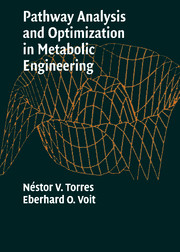Book contents
- Frontmatter
- Contents
- Preface
- 1 Target: A Useful Model
- 2 Methods of Biochemical Systems Theory
- 3 A Model of Citric Acid Production in the Mold Aspergillus niger
- 4 Optimization Methods
- 5 Optimization of Biochemical Systems
- 6 Optimization of Citric Acid Production in Aspergillus niger
- 7 Maximization of Ethanol Production in Saccharomyces cerevisiae
- 8 Conclusions
- Author Index
- Subject Index
- Plate section
- References
6 - Optimization of Citric Acid Production in Aspergillus niger
Published online by Cambridge University Press: 28 July 2009
- Frontmatter
- Contents
- Preface
- 1 Target: A Useful Model
- 2 Methods of Biochemical Systems Theory
- 3 A Model of Citric Acid Production in the Mold Aspergillus niger
- 4 Optimization Methods
- 5 Optimization of Biochemical Systems
- 6 Optimization of Citric Acid Production in Aspergillus niger
- 7 Maximization of Ethanol Production in Saccharomyces cerevisiae
- 8 Conclusions
- Author Index
- Subject Index
- Plate section
- References
Summary
INTRODUCTION
Optimization of yield and productivity has been a major goal since the very beginnings of industrial citric acid production. The first significant step in this regard is to be credited to Currie (1916, 1917), who observed that a large number of black Aspergillus strains were very active in the production of citric acid. With his extensive studies of culture media for the mold and his advances toward competitive production of citric acid through fermentation, Currie may also be considered the originator of efforts toward optimizing the biotechnological production process. In fact, Currie's success allowed the United States to become self-sufficient and even to export citric acid to Europe. Since Currie's seminal work, probably a thousand or more scientific studies have been published and several hundred patents issued.
Today, we are at a threshold of further significant improvements. The widespread accessibility of recombinant DNA technology and the possibility of altering phenotypes in specific directions and magnitudes are creating novel and powerful means of microbial manipulation (Archer, MacKenzie, and Jeenes 2001; Harwood and Wipat 2001). Combined with effective mathematical methods, these experimental tools are poised to propel microbial biotechnology to a new level of success. Mathematical guidance is necessary, because it is often no longer sufficient to overexpress the gene of one “rate-limiting” step. Instead, several molecular changes have to be introduced simultaneously and sometimes in very specific proportions, if any real improvements in yield or productivity are to be obtained.
- Type
- Chapter
- Information
- Pathway Analysis and Optimization in Metabolic Engineering , pp. 197 - 226Publisher: Cambridge University PressPrint publication year: 2002



